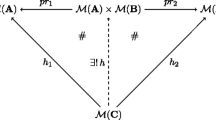Abstract
First, we discuss basic probability notions from the viewpoint of category theory. Our approach is based on the following four “sine quibus non” conditions: 1. (elementary) category theory is efficient (and suffices); 2. random variables, observables, probability measures, and states are morphisms; 3. classical probability theory and fuzzy probability theory in the sense of S. Gudder and S. Bugajski are special cases of a more general model; 4. a good model allows natural modifications.
Second, we show that the category ID of D-posets of fuzzy sets and sequentially continuous D-homomorphisms allows to characterize the passage from classical to fuzzy events as the minimal generalization having nontrivial quantum character: a degenerated state can be transported to a nondegenerated one.
Third, we describe a general model of probability theory based on the category ID so that the classical and fuzzy probability theories become special cases and the model allows natural modifications.
Finally, we present a modification in which the closed unit interval [0,1] as the domain of traditional states is replaced by a suitable simplex.
Similar content being viewed by others
References
Adámek J. (1983) Theory of Mathematical Structures. Reidel, Dordrecht
Bugajski S. (2001) ‘Statistical maps I. Basic properties’. Math. Slovaca 51: 321–342
Bugajski S. (2001) ‘Statistical maps II. Operational random variables’. Math. Slovaca 51: 343–361
Chovanec, F., and R. Frič, ‘States as morphisms’, Internat. J. Theoret. Phys., Published online: 30 December 2009, DOI 10.1007/s10773-009-0234-4.
Chovanec, F., and F. Kôpka, ‘D-posets’, in D. M. Gabbay K. Engesser, and D. Lehmann, (eds.), Handbook of Quantum Logic and Quantum Structures: Quantum Structures, Elsevier, Amsterdam, 2007, pp. 367–428.
Dvurečenskij, A., and S. Pulmannová, New Trends in Quantum Structures, Kluwer Academic Publ., Ister Science, Dordrecht, Bratislava, 2000.
Foulis D.J., Bennett M.K. (1994) ‘Effect algebras and unsharp quantum logics’. Found. Phys. 24: 1331–1352
Frič R. (2002) ‘Convergence and duality’. Appl. Categorical Structures. 10: 257–266
Frič R. (2002) ‘Łukasiewicz tribes are absolutely sequentially closed bold algebras’. Czechoslovak Math. J. 52: 861–874
Frič R. (2005) ‘Extension of measures: a categorical approach’. Math. Bohemica 130: 397–407
Frič R. (2005) ‘Remarks on statistical maps and fuzzy (operational) random variables’. Tatra Mountains Mathematical Publ. 30: 21–34
Frič R. (2007) ‘Statistical maps: a categorical approach’. Math. Slovaca 57: 41–57
Frič R. (2009) ‘Extension of domains of states’. Soft Comput. 13: 63–70
Frič, R., ‘States on bold algebras: categorical aspects’, Journal of Logic and Computation, Advance Access published March 13, 2009; DOI 10.1093/logcom/exp014.
Frič, R., and M. Papčo, ‘On probability domains’, Internat. J. Theoret. Phys., Published online: 15 October 2009, DOI 10.1007/s10773-009-0162-3.
Goguen J.A. (1991) ‘A categorical manifesto’. Math. Struct. in Comp. Science 1: 49–67
Gudder S. (1998) ‘Fuzzy probability theory’. Demonstratio Math. 31: 235–254
Kôpka F. (1992) ‘D-posets of fuzzy sets’. Tatra Mountains Mathematical Publ. 1: 83–87
Kôpka F., Chovanec F. (1994) ‘D-posets’. Math. Slovaca 44: 21–34
Mesiar R. (1992) ‘Fuzzy sets and probability theory’. Tatra Mountains Mathematical Publ. 1: 105–123
Mundici, D., and B. Riečan, ‘Probability on MV -algebras’, in E. Pap, (ed.), Handbook of Measure Theory, Vol. II, North-Holland, Amsterdam, 2002, pp. 869–910.
Novák J. (1968) ‘On sequential envelopes defined by means of certain classes of functions’. Czechoslovak Math. J. 18: 450–456
Papčo M. (2004) M. ‘On measurable spaces and measurable maps’. Tatra Mt. Math. Publ. 28: 125–140
Papčo M. (2005) ‘On fuzzy random variables: examples and generalizations’. Tatra Mt. Math. Publ. 30: 175–185
Papčo M. (2008) ‘On effect algebras of fuzzy sets’. Soft Comput. 12: 373–379
Riečan, B., and T. Neubrunn, Integral, Measure, and Ordering, Kluwer Acad. Publ., Dordrecht Boston London, 1997.
Zadeh L.A. (1968) ‘Probability measures of fuzzy events’. J. Math. Anal. Appl. 23: 421–427
Author information
Authors and Affiliations
Corresponding author
Rights and permissions
About this article
Cite this article
Frič, R., Papčo, M. A Categorical Approach to Probability Theory. Stud Logica 94, 215–230 (2010). https://doi.org/10.1007/s11225-010-9232-z
Published:
Issue Date:
DOI: https://doi.org/10.1007/s11225-010-9232-z




